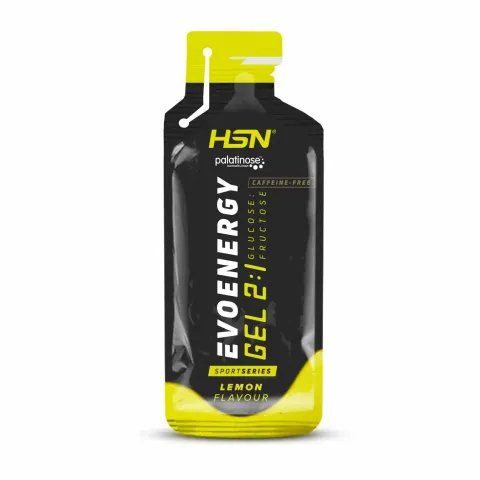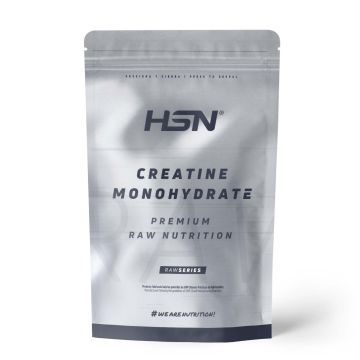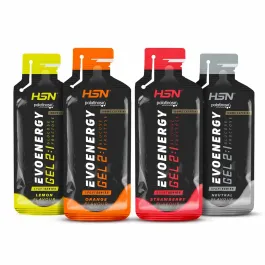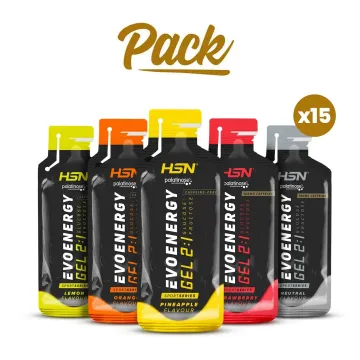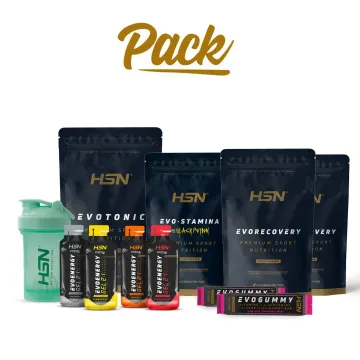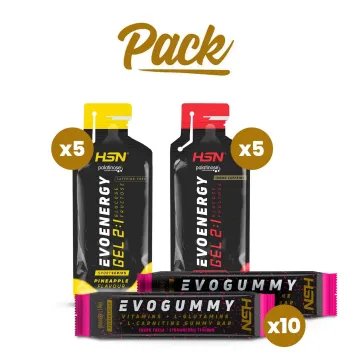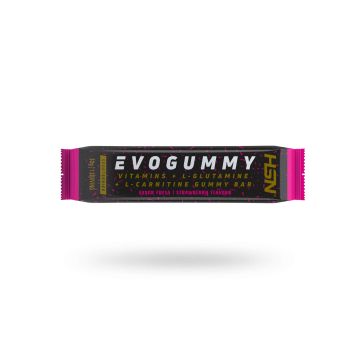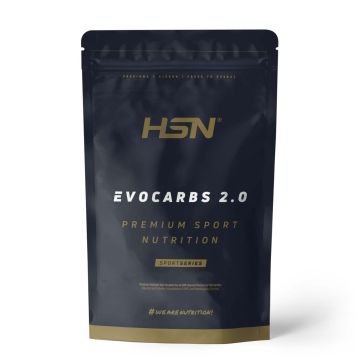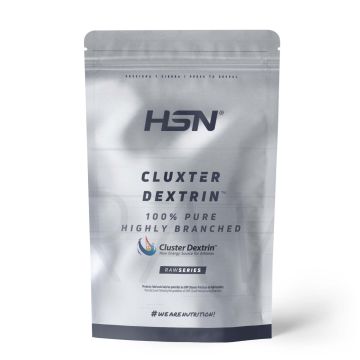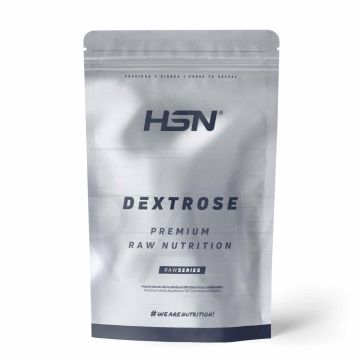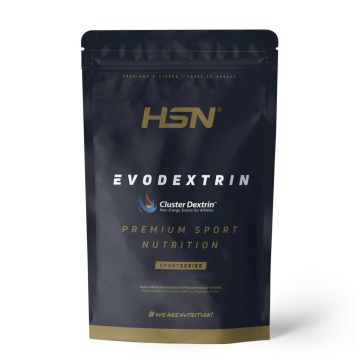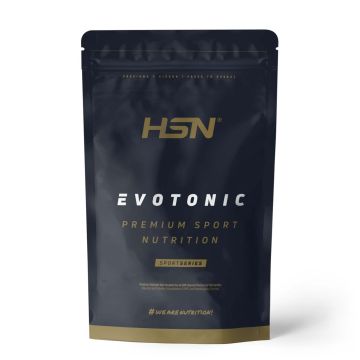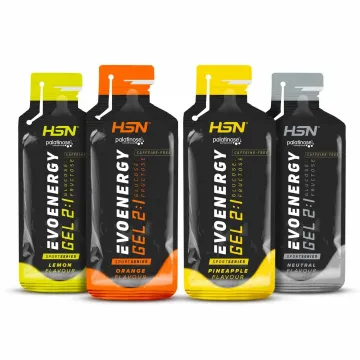- New Evoenergy Gel! - Improved consistency and nutritional composition.
- Reduced density in our classic gels. For a more comfortable intake.
- Caffeine-free version - Ideal for training or competitions in the late afternoon or at night.
- Provides 30g of carbohydrates per 55ml of gel (more concentrated format). Combine it with your isotonic drink.
- Flavours with adjusted sweetness - No added sweeteners - Delicious without leaving your mouth dry.
- Can be consumed without the need for water.
- Controlled Glucose: Fructose ratio - 2 units of glucose: 1 unit of fructose.
- Provides 100mg of sodium per gel to replenish sodium lost during sports activities.
New Evoenergy Gel - Your classic gel, improved
Evoenergy Gel Caffeine-Free by SportSeries is the caffeine-free version of HSN’s classic Evoenergy Gel. It is designed to provide a sequential absorption source of carbohydrates and mineral salts for rapid energy and electrolyte replenishment during sports, particularly in endurance activities with high sweat rates.
Evoenergy Gel is neither a hydro gel nor a maxi gel. It has moderate-to-high consistency (not gelatinised gels) and high tonicity (with a high concentration of carbohydrates and electrolytes), intended for use during sports practice. The reformulation of Evoenergy Gel has significantly improved its nutritional composition and reduced its consistency to make it smoother than the original version.
Evoenergy Gel is the ideal classic gel for amateur and casual athletes, as well as elite athletes, looking for a medium-density, high-concentration gel to combine with water or an isotonic drink.
Is Evoenergy Gel the best choice for me?
Evoenergy Gel vs Hydro Gels
When choosing a gel, you’ll find two main options on the market, distinguished by their consistency: standard gels (like Evoenergy Gel) and hydro gels.
There are arguments supporting the use of one type of gel over another, but ultimately, it’s a matter of personal preference. At HSN, we recommend trying classic-consistency gels (thicker) and hydro gels to decide which suits you best.
Traditional gels are thicker, making them more 'substantial'. Some athletes prefer gels closer to a drink, like hydro versions, while others enjoy the sensation of thicker gels.
It’s common to start with Evoenergy Gel, the traditional version, and then try Hydro to compare. Traditional gels remain the most popular choice in the sports world and are generally recommended for athletes of all levels. However, if you have difficulty swallowing thicker preparations during training, hydro gels might better suit your needs.
Evoenergy Gel’s consistency
When discussing gels, we often refer to their consistency to help you get an idea of their texture:
- There are ultra-dense gels, which are a smooth paste designed to be swallowed, not drunk, like a high-consistency gel that isn’t fluid but can be easily gulped. While some athletes love these gels, most find them hard to consume and unusual. Evoenergy Gel is NOT this type of gel.
- There are ultra-light gels, called 'Hydro,' with a watery base and slightly thicker than a sports drink. These are made for people who dislike eating during exercise and prefer drinks. Evoenergy Gel is NOT this type of gel.
- And then there are normal gels, with a consistency ranging between drinkable yogurt and custard. The density of our first version was closer to custard, whereas our current Evoenergy Gel is smoother, easier to consume, and flows better through the nozzle—without being hydro. Now it has a lighter consistency. This is the density of Evoenergy Gel.
Evoenergy Gel is highly digestible. Despite this, it’s a hypertonic gel because of its high concentration of carbohydrates and mineral salts. For more sensitive individuals, we recommend diluting it in water, like a sports drink, or using a hydro version.
2:1 Glucose: Fructose Ratio – Why?
Around 2010, Dutch researcher and triathlete Asker Jeukendrup, an expert in endurance sports nutrition, identified the intestinal absorption limit for glucose.
Since then, scientific research and sports practices have begun adding fructose to sports drinks and gels, as fructose offers similar benefits to glucose in isotonic drinks without the absorption limitations.
The ideal carbohydrate ratio was traditionally set at 2:1, with potential adjustments to 1:0.8 in specific cases. We’ve improved the nutritional composition of our Evoenergy Gel by aligning it with the glucose:fructose ratio most used in high-performance sports:
2 units of glucose for every unit of fructose.
This ratio is crucial when consuming more than 90g of carbohydrates per hour of exercise. While each gel provides 30g, which may seem low, 30g per hour is insufficient for most cases. Evoenergy Gel adheres to this ratio because it’s designed to be used alongside other carbohydrate sources, like isotonic drinks or bars.
A high-concentration gel: 30g of carbohydrates + 100mg of sodium in 55ml
Although Evoenergy Gel’s absolute carbohydrate content isn’t particularly high, its concentration is, with an osmolarity exceeding 54%. This makes it a highly hypertonic preparation, ideal for consumption alongside water or hypotonic drinks during exercise.
All in a compact 55ml single-dose format, easy to consume.
Evoenergy Gel is a high-concentration option, perfect for delivering a boost of carbohydrates and minerals during sports activities.
Caffeine-free version – The ‘on-the-go’ solution for everyone
There are gel versions containing stimulants like caffeine. In fact, our catalogue includes a caffeinated Evoenergy Gel, delivering 100mg of caffeine per unit.
However, not everyone wants stimulants in their gels. This might be due to sensitivity to their effects, late training sessions where caffeine could disrupt sleep, or ultradistance events where athletes take multiple gels and strategically combine caffeinated and caffeine-free versions.
The caffeine-free Evoenergy Gel is the easiest version to use as a first introduction to sports gels. It’s also the 'base gel' generally used by athletes of all levels, from complete beginners to professionals training or competing in long-duration endurance events.
How to integrate the gel into your intra-workout nutrition?
How you use Evoenergy Gel during training depends on your needs:
Typically, the recommended amount is 60 to 120g of carbohydrates per hour of physical activity. 60g is on the lower end, while 120g is suitable only for athletes with high digestive adaptation.
With 30g of carbohydrates, 1 Evoenergy Gel provides 33% of the average hourly carbohydrate intake, making it an excellent option to pair with an isotonic drink containing carbohydrates and electrolytes, such as Evocarbs 2.0, which supplies the remaining 60g per hour.
Bibliographic References
- Naderi, A., Gobbi, N., Ali, A., Berjisian, E., Hamidvand, A., Forbes, S. C., … Saunders, B. (2023). Carbohydrates and Endurance Exercise: A Narrative Review of a Food First Approach. Nutrients, 15(6).
- Kozlowski, K. F., Ferrentino-Depriest, A., & Cerny, F. (2021). Effects of Energy Gel Ingestion on Blood Glucose, Lactate, and Performance Measures During Prolonged Cycling. Journal of Strength and Conditioning Research, 35(11), 3111–3119.
- Podlogar, T., & Wallis, G. A. (2022). New Horizons in Carbohydrate Research and Application for Endurance Athletes. Sports Medicine, 52(Suppl 1), 5–23.
- Patterson, S. D., & Gray, S. C. (2007). Carbohydrate-gel supplementation and endurance performance during intermittent high-intensity shuttle running. International Journal of Sport Nutrition and Exercise Metabolism, 17(5), 445–455.
- Phillips, S. M., Turner, A. P., Sanderson, M. F., Sproule, J., & Ward, S. A. (2012). Carbohydrate gel ingestion significantly improves the intermittent endurance capacity, but not sprint performance, of adolescent team games players during a simulated team games protocol. European Journal of Applied Physiology, 112(3), 1133–1141.
- Saunders, M. J., Luden, N. D., & Herrick, J. E. (2007). Consumption of an oral carbohydrate-protein gel improves cycling endurance and prevents postexercise muscle damage. Journal of Strength and Conditioning Research, 21(3), 678–684.
- Naderi, A., Gobbi, N., Ali, A., Berjisian, E., Hamidvand, A., Forbes, S. C., … Saunders, B. (2023). Carbohydrates and Endurance Exercise: A Narrative Review of a Food First Approach. Nutrients, 15(6).
- Vitale, K., & Getzin, A. (2019). Nutrition and supplement update for the endurance athlete: Review and recommendations. Nutrients, 11(6).
 Before
Before After
After During
During Morning
Morning Afternoon
Afternoon Night
Night Before
Before After
After During
During Morning
Morning Afternoon
Afternoon Night
Night Before
Before After
After During
During Morning
Morning Afternoon
Afternoon Night
Night Before
Before After
After During
During Morning
Morning Afternoon
Afternoon Night
Night
 Delivery in 3-5 working days
Delivery in 3-5 working days






